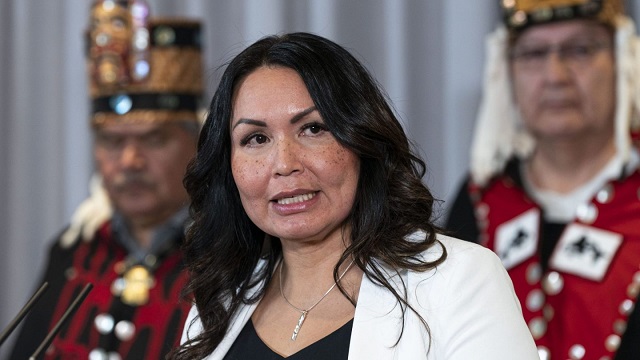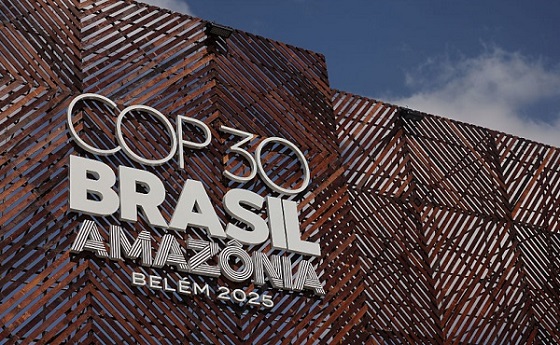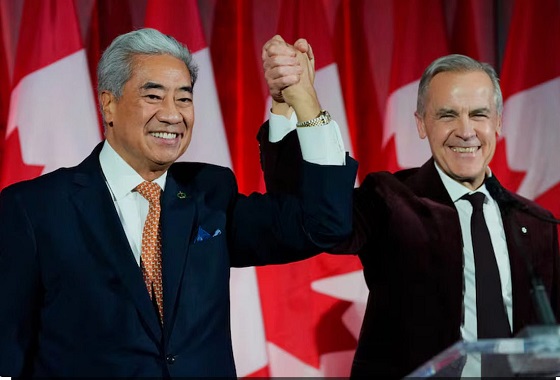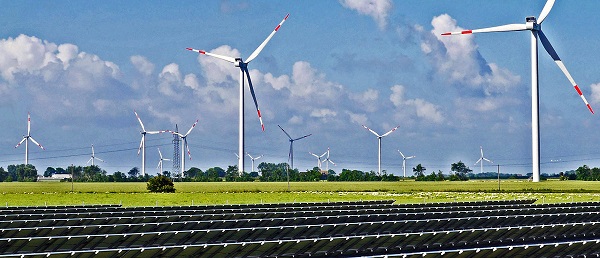Energy
LNG leader: Haisla Nation Chief Councillor Crystal Smith on the world’s first Indigenous project

Haisla Nation Chief Councillor Crystal Smith during a press conference announcing that the Cedar LNG project has been given environmental approval in Vancouver, Tuesday March 14, 2023. CP Images photo
From the Canadian Energy Centre
By Will Gibson‘Now we are working together to make our own opportunities as owners and developers of the resource’
Growing up in the 1980s, Crystal Smith felt supported and nourished by her community, the Haisla Nation along the shores of Kitimat, British Columbia. But at the same time, she also sensed the outside world had placed some limitations on her future.
“I enjoyed a wonderful childhood with a solid foundation and lots of love, especially from my grandma Cecilia Smith. She raised me because I lost my mother and stepdad at a young age. But it wasn’t popular to be Indigenous when I grew up,” says Smith.
“A lot of people would talk about how Indigenous people were not expected to be successful. That kind of talk really affected my confidence about what I could be.”
Smith, now the Haisla Nation’s elected chief councillor, never wants children in her community to feel those constraints.
Her community has seized on a major opportunity to build prosperity and resiliency for future generations. The Haisla Nation is a partner in the proposed $3.4 billion Cedar LNG project, the world’s first to have Indigenous ownership. A final go-ahead decision for the project to proceed is expected by the middle of this year.
Smith, who has served as board chair of the First Nations LNG Alliance since 2019, has already seen tangible changes in her community since the project was announced.
“It’s hard to put into words about the impact on the ground in terms of how this opportunity has affected our members in their lives,” she says.
“We were just interviewing candidates to serve as board directors on our economic development corporation and one candidate, who is from our community, just amazed me with how far he has come in terms of pursuing his education and how much his career has progressed.”
 The town of Kitimat on British Columbia’s west coast. LNG Canada site in background. Photo courtesy District of Kitimat
The town of Kitimat on British Columbia’s west coast. LNG Canada site in background. Photo courtesy District of Kitimat
Of her own career, Smith says she knew since college that her future was in serving the community. She started working in the Haisla band administration in 2009 and was first elected chief councillor in 2017.
“I was lucky because my family really pushed me to seek an education after high school, so I took the business program at Coast Mountain College. I also helped that I had mentors in my community, including my father Albert Robinson, who served as an elected Haisla councillor, and Ellis Ross (now an elected MLA in B.C), who was very inspiring in terms of his vision as chief councillor and encouraged me to take the step into elected office,” Smith says.
“When I came back to the community from school, I knew I would end up working in our band office. I wanted to see more opportunities for people in my community and LNG provides that.”
She already sees the benefits of the development, as well as the Haisla Nation’s participation in the LNG Canada project, within her own family including for her grandsons.
“Xavier is six and he goes to the same school I attended as a child. He gets to learn parts of our culture, our teachings, as well as the value and importance of family and community. There’s more of an emphasis on our language and culture in the curriculum, which really makes me happy. Luka, who just turned two, will also attend that school when he’s old enough,” Smith says.
“I want programs and services to meet our needs, not the level of government’s needs. And we need to make sure that it is sustainable not just for my grandsons or their peers but for seven generations beyond this one.”
Cedar LNG is coming closer and closer to fruition, with all permits in place and early construction underway.
An eight-kilometre pipeline will be built connecting the recently completed Coastal GasLink pipeline to deliver natural gas to the floating Cedar LNG terminal located along the Douglas Channel near Kitimat.
The facility will be capable of producing up to three million tonnes of liquefied natural gas every year, which will be transported by carriers through the Douglas Channel to Hecate Straight, using the existing deepwater shipping lane, to reach customers in the Asia-Pacific region.
Powered entirely by renewable energy from BC Hydro, Cedar LNG will be one of the lowest carbon intensity LNG facilities in the world. Its so-called emissions intensity will be 0.08 per cent CO2 per tonne, compared to the global average of 0.35 per cent per tonne.

Up to 500 people will work on the project during the peak of construction. Approximately 100 people will be working at the facility full-time during operation, which is expected to start in the second half of 2028.
Smith says the benefits of the project will extend beyond the 2,000 members of the Haisla Nation.
“This work has really helped us reconnect with other Indigenous communities along pipelines and shipping routes,” she says.
“When I was growing up, our communities never had the opportunity to come together because we were separated by the territorial boundaries imposed by the Indian Act. And we were fighting each other for financial scraps from Indian Affairs.
“Now we are working together to make our own opportunities as owners and developers of the resource. That’s very empowering and the most important part. Participating in developing these resources provides independence. It’s the only solution for my nation and other Indigenous communities.”
Energy
Liberals Twisted Themselves Into Pretzels Over Their Own Pipeline MOU

From Energy Now
By Margareta Dovgal
Playing politics with pipelines is a time-honored Canadian tradition. Recent events in the House of Commons offered a delightful twist on the genre.
The Conservatives introduced a motion quoting the Liberals’ own pipeline promises laid out in the Memorandum of Understanding (MOU) with Alberta, nearly verbatim. The Liberals, true to form, killed it 196–139 with enthusiastic help from the NDP, Bloc, and Greens.
We all knew how this would end. Opposition motions like this never pass; no government, especially not one led by Mark Carney, is going to let the opposition dictate the agenda. There’s not much use feigning outrage that the Liberals voted it down. The more entertaining angle has been watching closely as Liberal MPs twist themselves into pretzels explaining why they had to vote “no” on a motion that cheers on a project they claim to support in principle.
Liberal MP Corey Hogan dismissed the motion as “game-playing” designed to “poke at people”.
And he’s absolutely right to call it a “trap” for the Liberals. But traps only work when you walk into them.
Indigenous Services Minister Mandy Gull-Masty deemed the motion an “immature waste of parliamentary time” and “clearly an insult towards Indigenous Peoples” because it didn’t include every clause of the original agreement. Energy Minister Tim Hodgson decried it as a “cynical ploy to divide us” that “cherry-picked” the MOU.
Yet the prize for the most tortured metaphor goes to the prime minister himself. Defending his vote against his own pipeline promise, Carney lectured the House that “you have to eat the entire meal, not just the appetizer.”
It’s a clever line, and it also reveals the problem. The “meal” Carney is serving is stuffed with conditions. Environmental targets or meaningful engagement with Indigenous communities aren’t unrealistic asks. A crippling industrial carbon price as a precondition might be though.
But the prime minister has already said the quiet part out loud.
Speaking in the House a few weeks ago, Carney admitted that the agreement creates “necessary conditions, but not sufficient conditions,” before explicitly stating: “We believe the government of British Columbia has to agree.”
There is the poison pill. Handing a de facto veto to a provincial government that has spent years fighting oil infrastructure is neither constitutionally required nor politically likely. Elevating B.C.’s “agreement” to a condition, which is something the MOU text itself carefully avoids doing, means that Carney has made his own “meal” effectively inedible.
Hodgson’s repeated emphasis that the Liberal caucus supports “the entire MOU, the entire MOU” only reinforces this theory.
This entire episode forces us to ask whether the MOU is a real plan to build a pipeline, or just a national unity play designed to cool down the separatist temperature in Alberta. My sense is that Ottawa knew they had to throw a bone to Premier Danielle Smith because the threat of the sovereignty movement is gaining real traction. But you can’t just create the pretense of negotiation to buy time.
With the MOU getting Smith boo’ed at her own party’s convention by the separatists, it’s debatable whether that bone was even an effective one to throw.
There is a way. The federal government has the jurisdiction. If they really wanted to, they could just do it, provided the duty to consult with and accommodate Indigenous peoples was satisfied. Keep in mind: no reasonable interpretation equates Section 35 of the Charter to a veto.
Instead, the MOU is baked with so many conditions that the Liberals have effectively laid the groundwork for how they’re going to fail.
With overly-hedged, rather cryptic messaging, Liberals have themselves given considerable weight to a cynical theory, that the MOU is a stalling tactic, not a foundation to get more Canadian oil to the markets it’s needed in. Maybe Hodgson is telling the truth, and caucus is unified because the radicals are satisfied that “the entire MOU” ensures that a new oil pipeline will never reach tidewater through BC.
So, hats off to the legislative affairs strategists in the Conservative caucus. The real test of Carney’s political power continues: can he force a caucus that prefers fantasy economics into a mold of economic literacy to deliver on the vision Canadians signed off on? Or will he be hamstrung trying to appease the radicals from within?
Margareta Dovgal is managing director of Resource Works Society.
Daily Caller
Paris Climate Deal Now Decade-Old Disaster


From the Daily Caller News Foundation
By Steve Milloy
The Paris Climate Accord was adopted 10 years ago this week. It’s been a decade of disaster that President Donald Trump is rightly trying again to end.
The stated purpose of the agreement was for countries to voluntarily cut emissions to avoid the average global temperature exceeding the (guessed at) pre-industrial temperature by 3.6°F (2°C) and preferably 2.7°F (1.5°C).
Since December 2015, the world spent an estimated $10 trillion trying to achieve the Paris goals. What has been accomplished? Instead of reducing global emissions, they have increased about 12 percent. While the increase in emissions is actually a good thing for the environment and humanity, spending $10 trillion in a failed effort to cut emissions just underscores the agreement’s waste, fraud and abuse.
As a nonprofit, we are dependent on the generosity of our readers.
Please consider making a small donation of any amount here.
Thank you!
But wasting $10 trillion is only the tip of the iceberg.
The effort to cut emissions was largely based on forcing industrial countries to replace their tried-and-true fossil fuel-based energy systems with not-ready-for-prime-time wind, solar and battery-based systems. This forced transition has driven up energy costs and made energy systems less reliable. The result of that has been economy-crippling deindustrialization in former powerhouses of Germany and Britain.
And it gets worse.
European nations imagined they could reduce their carbon footprint by outsourcing their coal and natural gas needs to Russia. That outsourcing enriched Russia and made the European economy dependent on Russia for energy. That vulnerability, in turn, and a weak President Joe Biden encouraged Vladimir Putin to invade Ukraine.
The result of that has been more than one million killed and wounded, the mass destruction of Ukraine worth more than $500 billion so far and the inestimable cost of global destabilization. Europe will have to spend hundreds of billions more on defense, and U.S. taxpayers have been forced to spend hundreds of billions on arms for Ukraine. Putin has even raised the specter of using nuclear weapons.
President Barack Obama unconstitutionally tried to impose the Paris agreement on the U.S. as an Executive agreement rather than a treaty ratified by the U.S. Senate. Although Trump terminated the Executive agreement during his first administration, President Joe Biden rejoined the agreement soon after taking office, pledging to double Obama’s emissions cuts pledge to 50 percent below 2005 levels by 2030.
Biden’s emissions pledge was an impetus for the 2022 Inflation Reduction Act that allocated $1.2 trillion in spending for what Trump labeled as the Green New Scam. Although Trump’s One Big Beautiful Bill Act reduced that spending by about $500 billion and he is trying to reduce it further through Executive action, much of that money was used in an effort to buy the 2024 election for Democrats. The rest has been and will be used to wreck our electricity grid with dangerous, national security-compromising wind, solar and battery equipment from Communists China.
Then there’s this. At the Paris climate conference in 2015, U.S. Secretary of State John Kerry stated quite clearly that emissions cuts by the U.S. and other industrial countries were meaningless and would accomplish nothing since the developing world’s emissions would be increasing.
Finally, there is the climate realism aspect to all this. After the Paris agreement was signed and despite the increase in emissions, the average global temperature declined during the years from 2016 to 2022, per NOAA data.
The super El Nino experienced during 2023-2024 caused a temporary temperature spike. La Nina conditions have now returned the average global temperature to below the 2015-2016 level, per NASA satellite data. The overarching point is that any “global warming” that occurred over the past 40 years is actually associated with the natural El Nino-La Nina cycle, not emissions.
The Paris agreement has been all pain and no gain. Moreover, there was never any need for the agreement in the first place. A big thanks to President Trump for pulling us out again.
Steve Milloy is a biostatistician and lawyer. He posts on X at @JunkScience.
-

 Business12 hours ago
Business12 hours agoCanada Hits the Brakes on Population
-

 Crime56 mins ago
Crime56 mins agoBrown University shooter dead of apparent self-inflicted gunshot wound
-

 Business2 days ago
Business2 days agoOttawa Pretends To Pivot But Keeps Spending Like Trudeau
-

 International1 day ago
International1 day agoBondi Beach Shows Why Self-Defense Is a Vital Right
-

 Crime1 day ago
Crime1 day agoThe Uncomfortable Demographics of Islamist Bloodshed—and Why “Islamophobia” Deflection Increases the Threat
-

 Crime1 day ago
Crime1 day agoBondi Beach Survivor Says Cops Prevented Her From Fighting Back Against Terrorists
-

 International1 day ago
International1 day agoHouse Rejects Bipartisan Attempt To Block Trump From Using Military Force Against Venezuela
-

 Energy2 days ago
Energy2 days agoLiberals Twisted Themselves Into Pretzels Over Their Own Pipeline MOU









